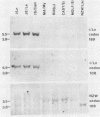Abstract
The mouse prion protein (PrP) gene (Prn-p), which encodes the only macromolecule that has been identified in scrapie prions, is tightly linked or identical to a gene (Prn-i) that controls the duration of the scrapie incubation period in mice. Constellations of restriction fragment length polymorphisms distinguish haplotypes a to f of Prn-p. The Prn-pb allele encodes a PrP that differs in sequence from those encoded by the other haplotypes and, in inbred mouse strains, correlates with long scrapie incubation time (Westaway et al., Cell 51: 651-662, 1987). In segregating crosses of mice, we identified rare individuals with a divergent scrapie incubation time phenotype and Prn-p genotype, but progeny testing to demonstrate meiotic recombination was not possible because scrapie is a lethal disease. Crosses involving the a, d, and e haplotypes demonstrated that genes unlinked to Prn-p could modulate scrapie incubation time and that there were only two alleles of Prn-i among the mouse strains tested. All inbred strains of mice that had the Prnb haplotype were probably direct descendants of the I/LnJ progenitors. We established the linkage relationship between the prion gene complex (Prn) and other chromosome 2 genes; the gene order, proximal to distal, is B2m-II-1a-Prn-Itp-A. Recombination suppression in the B2m-Prn-p interval occurred during the crosses involved in transferring the I/LnJ Prnb complex into a C57BL/6J background. Transmission ratio distortion by Prna/Prnb heterozygous males was also observed in the same crosses. These phenomena, together with the founder effect, would favor apparent linkage disequilibrium between Prn-p and Prn-i. Therefore, transmission genetics may underestimate the number of genes in Prn.
Full text
PDF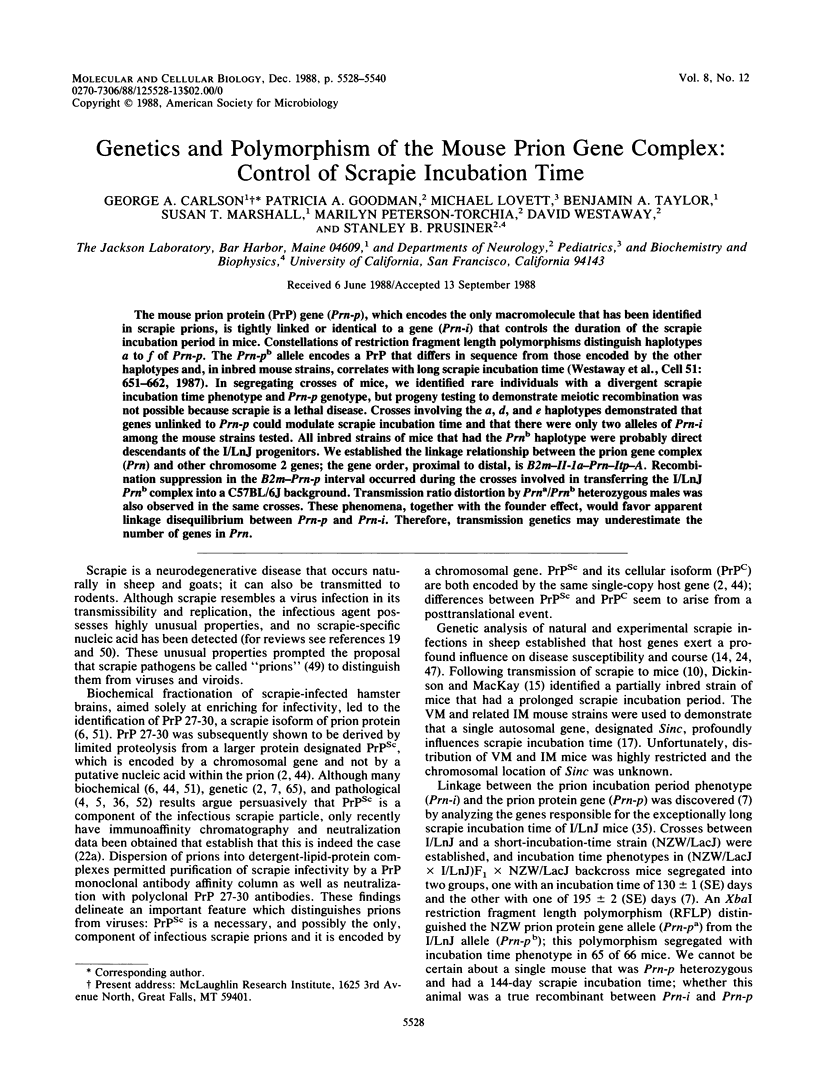
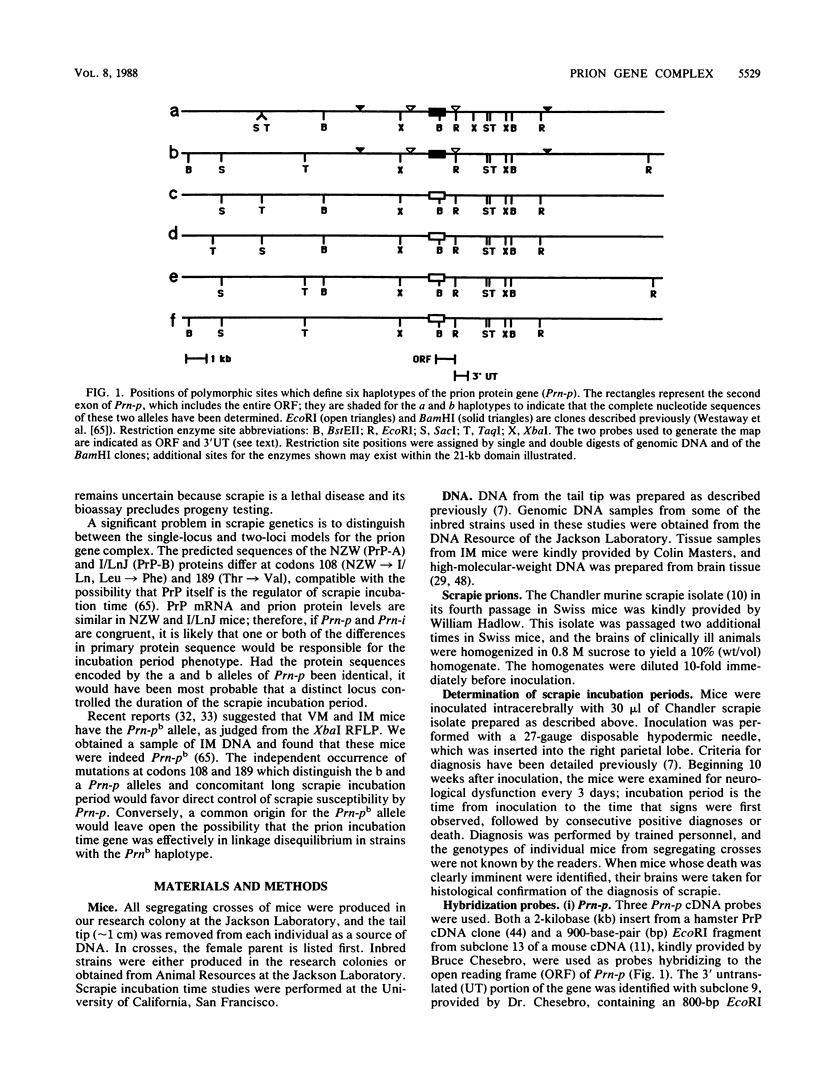
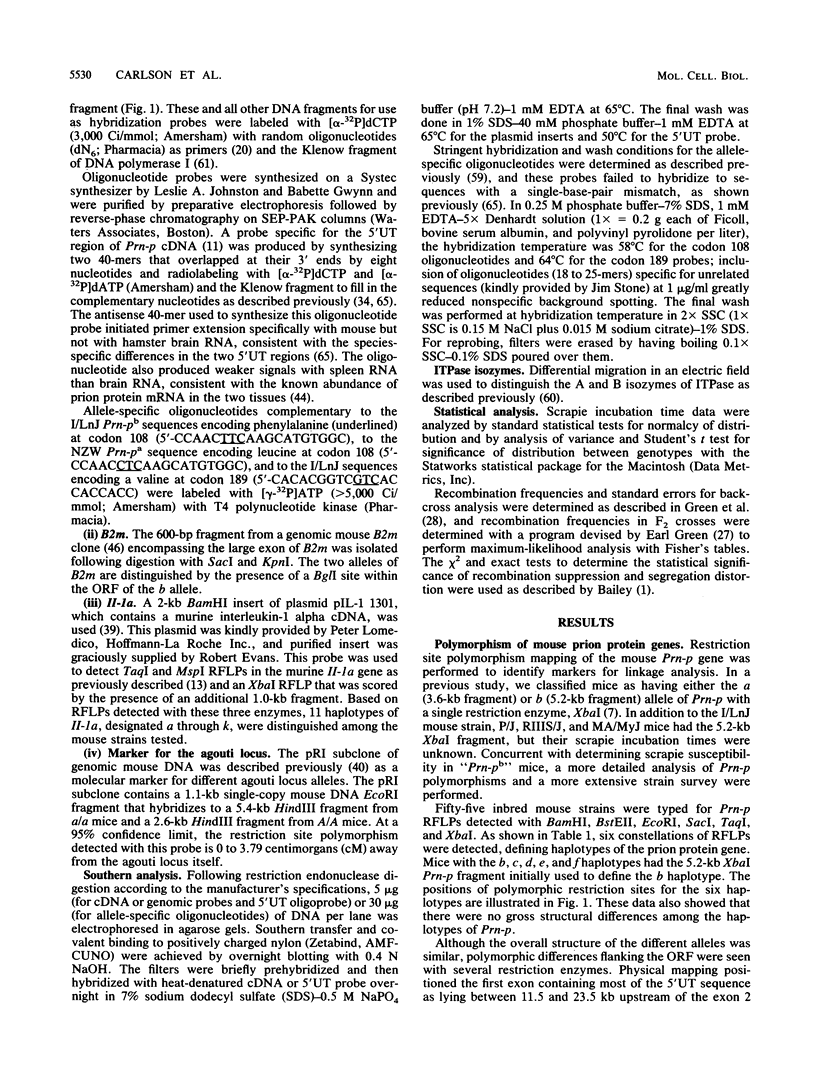
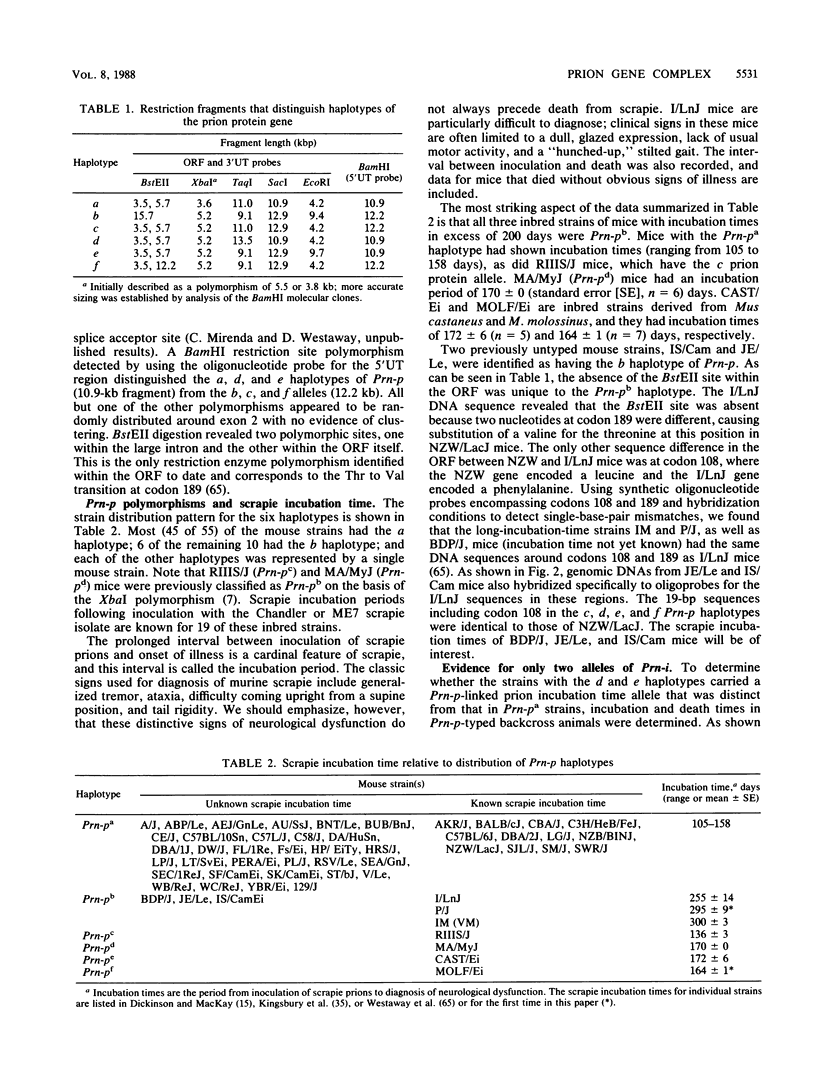
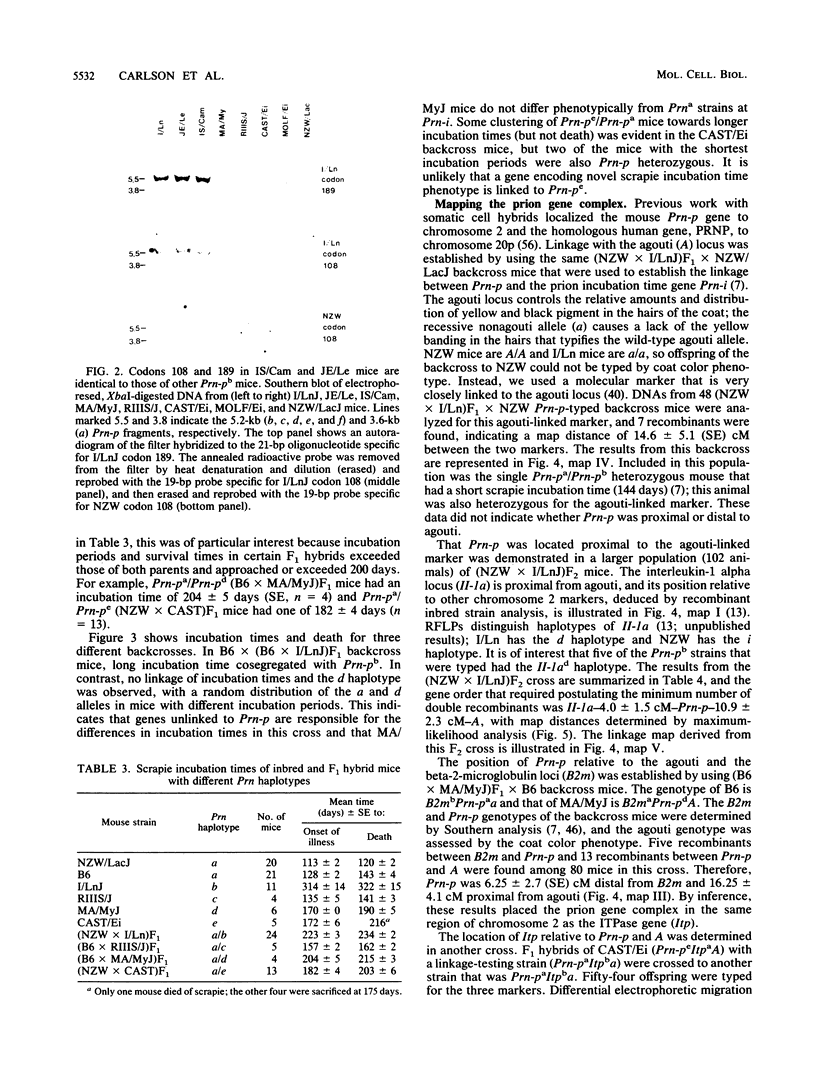
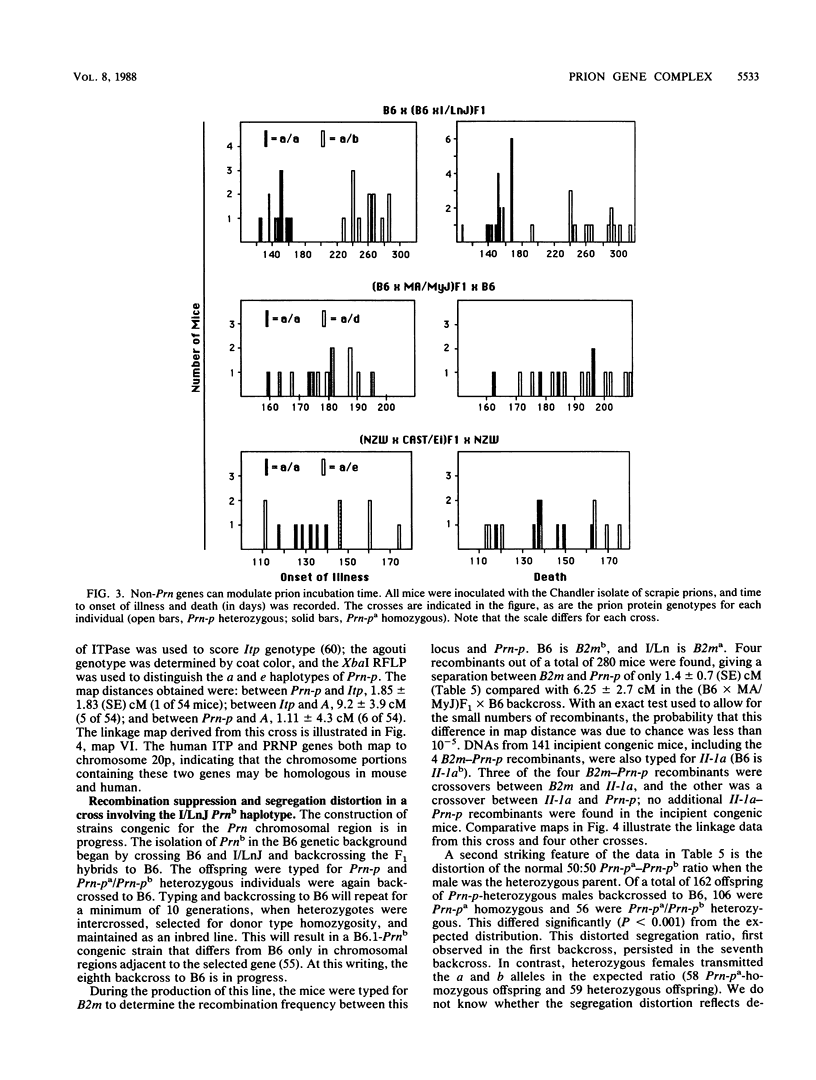
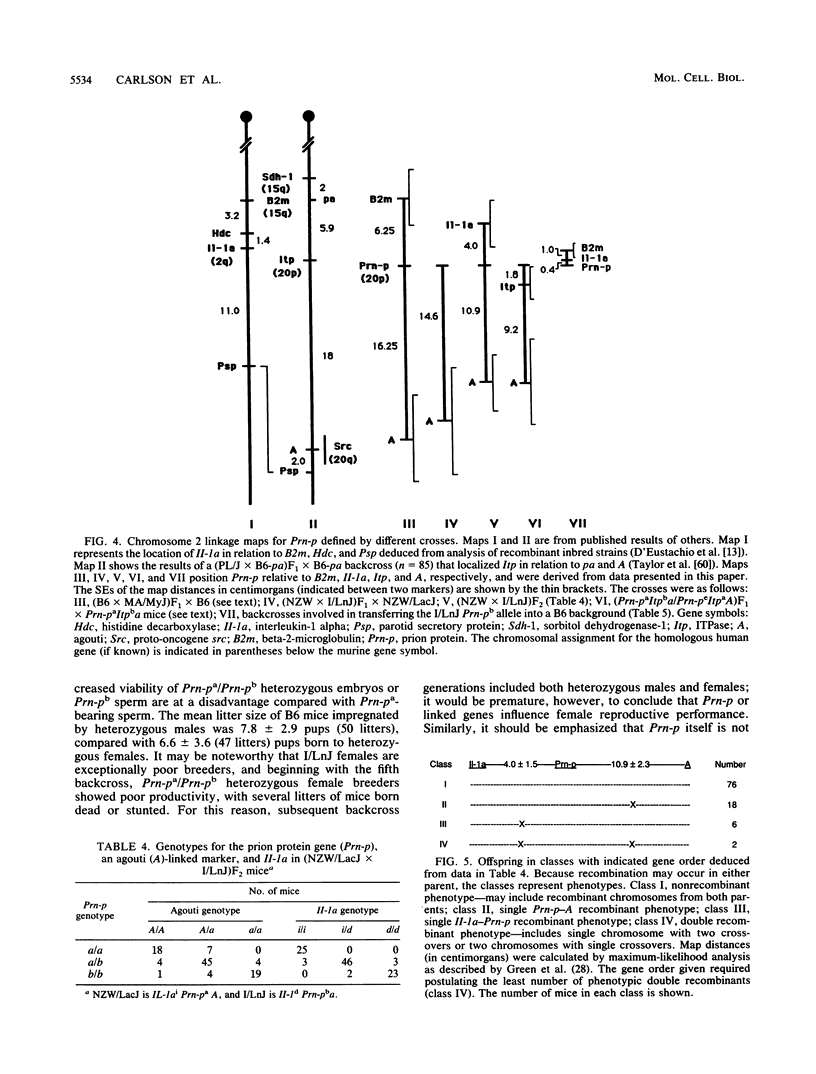
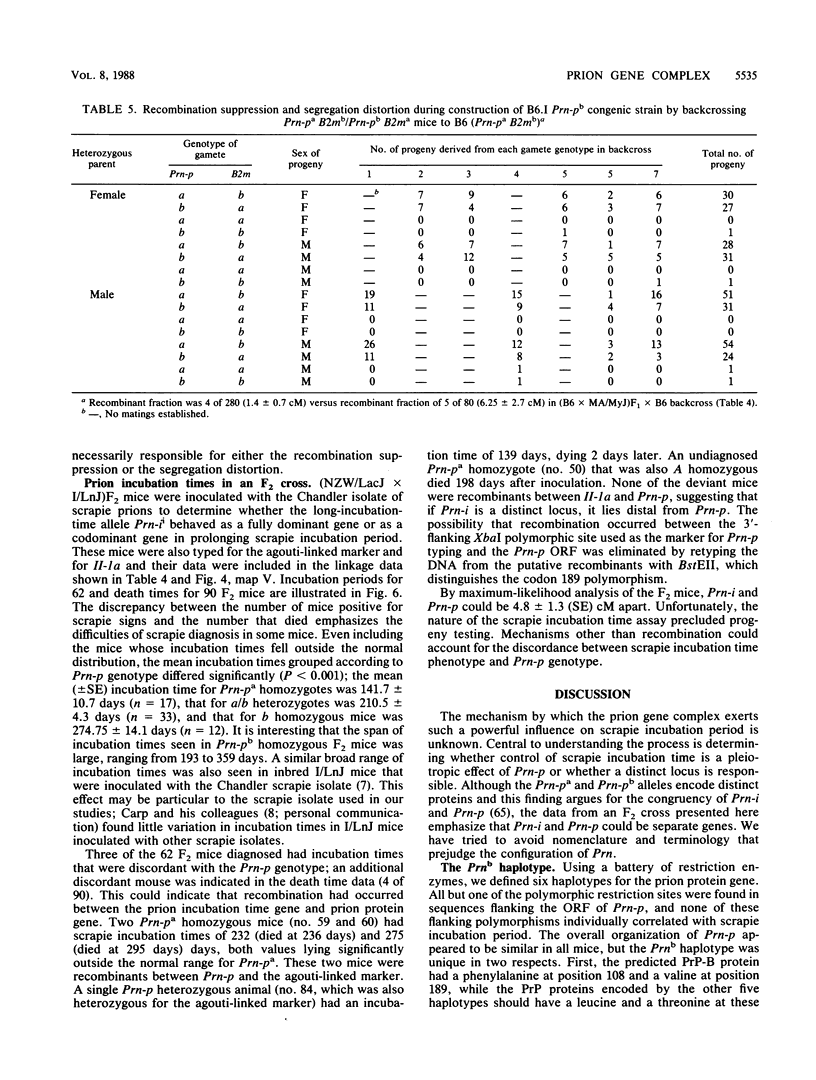
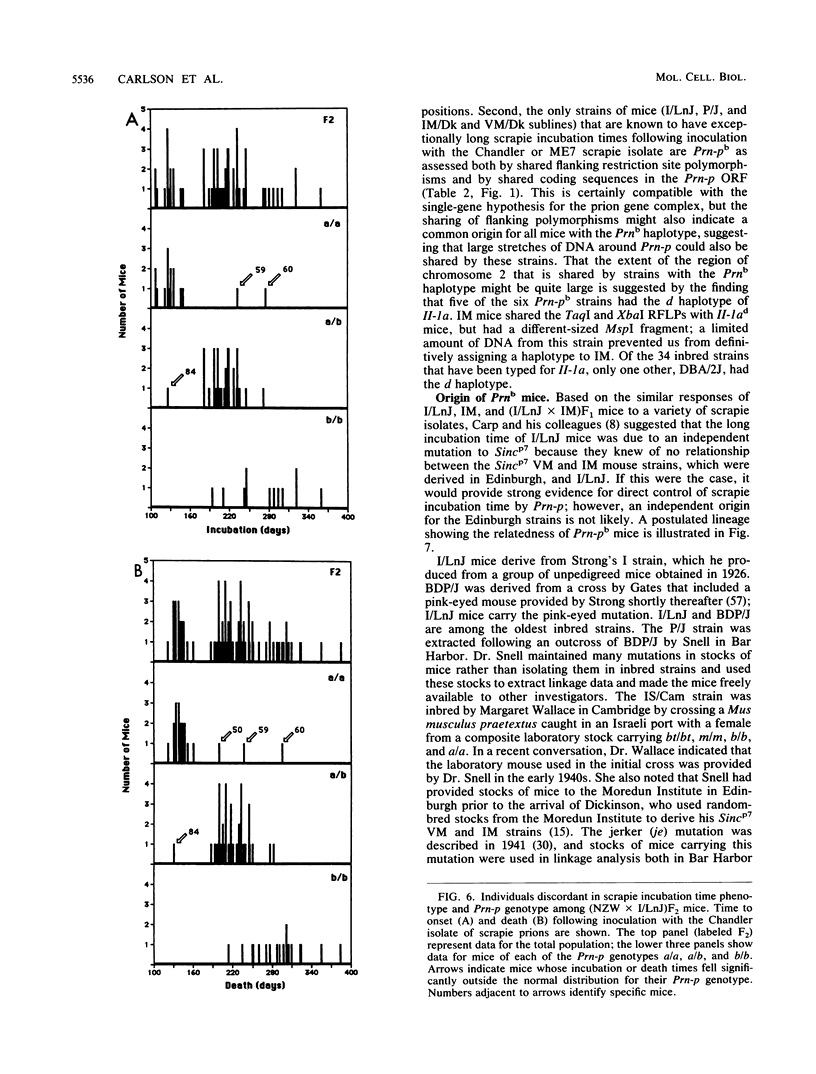
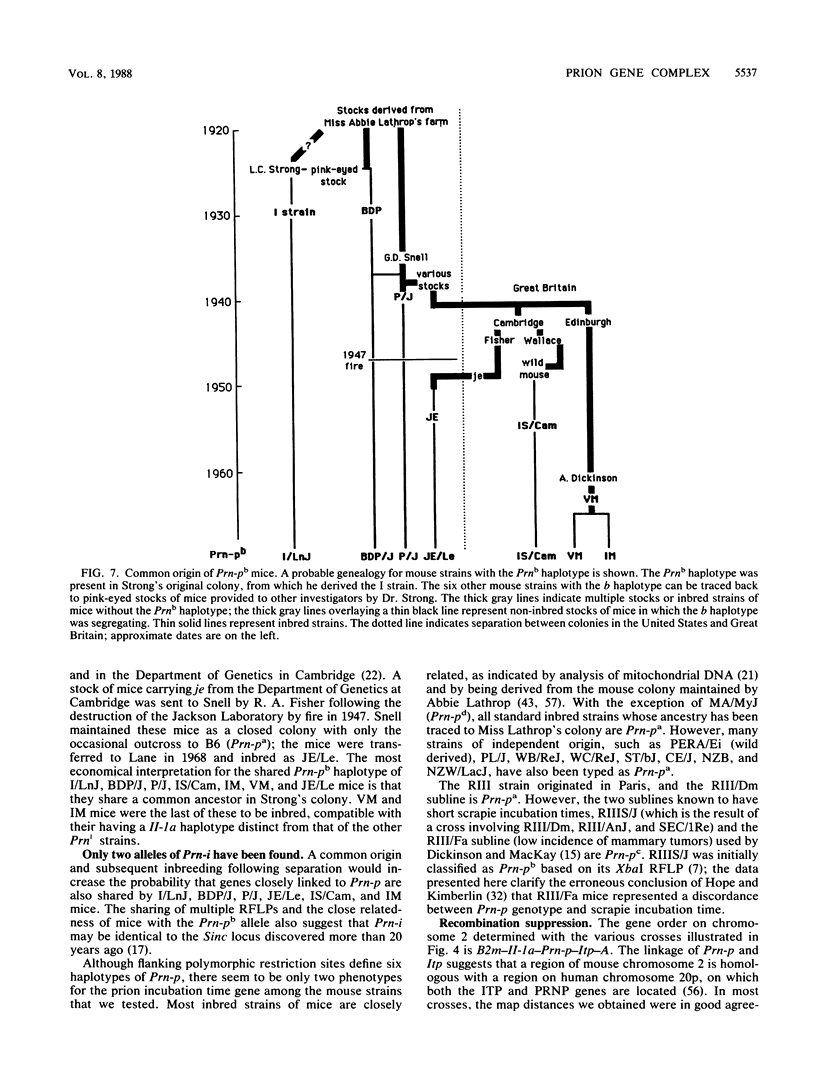
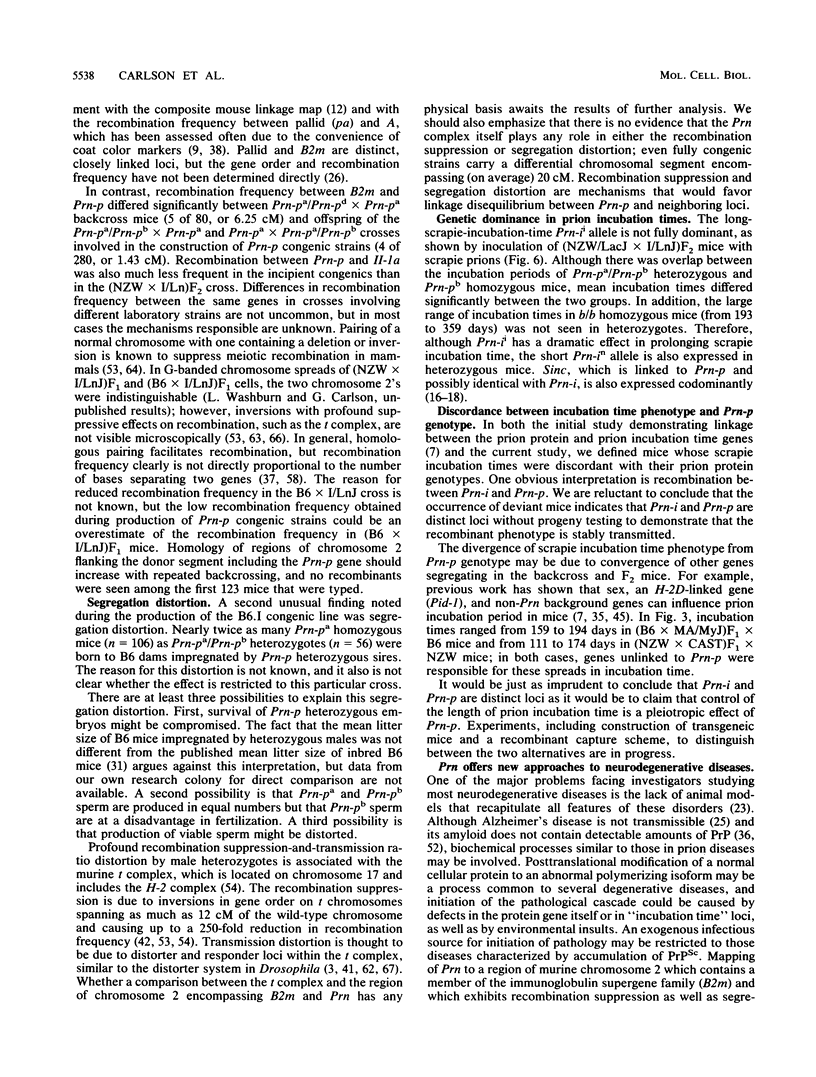
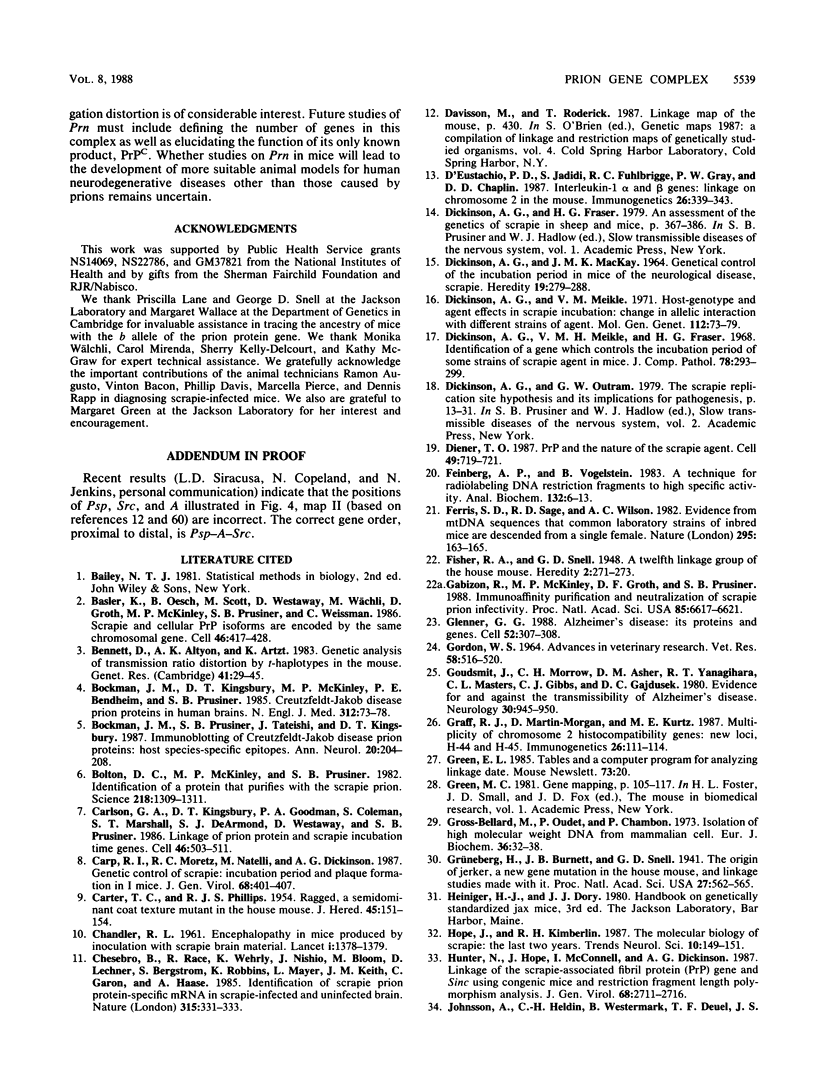
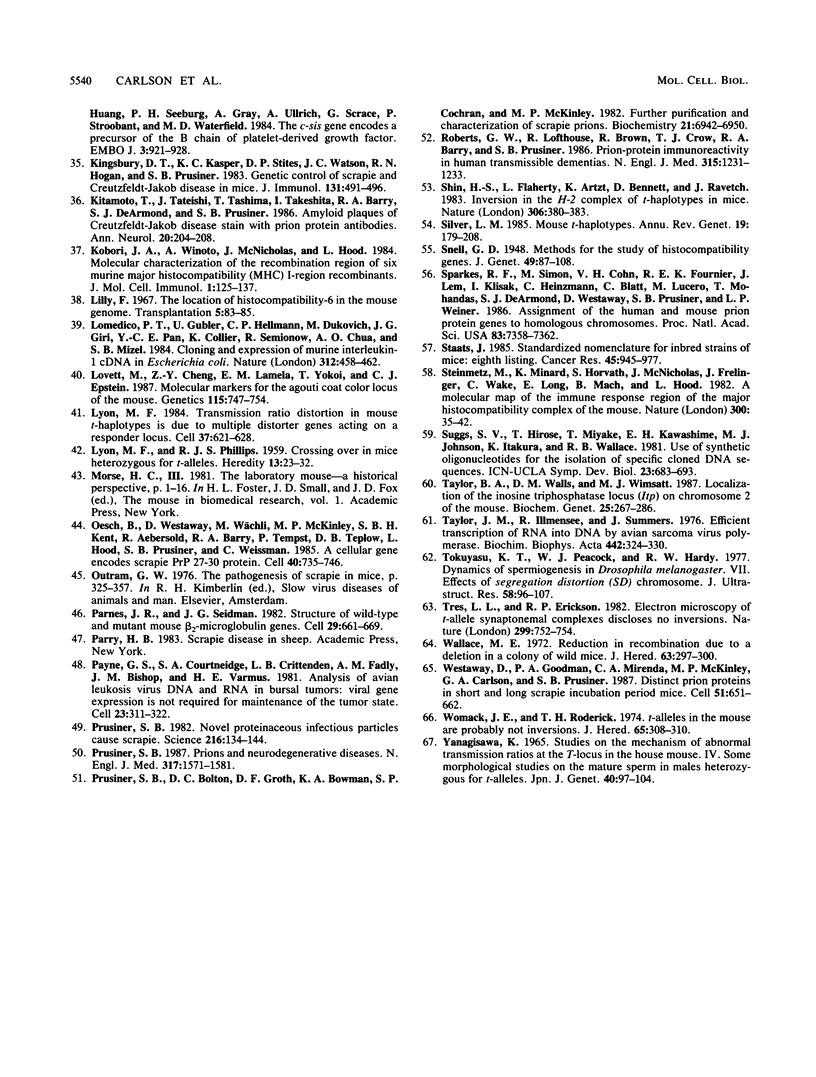
Images in this article
Selected References
These references are in PubMed. This may not be the complete list of references from this article.
- Basler K., Oesch B., Scott M., Westaway D., Wälchli M., Groth D. F., McKinley M. P., Prusiner S. B., Weissmann C. Scrapie and cellular PrP isoforms are encoded by the same chromosomal gene. Cell. 1986 Aug 1;46(3):417–428. doi: 10.1016/0092-8674(86)90662-8. [DOI] [PubMed] [Google Scholar]
- Bennett D., Alton A. K., Artzt K. Genetic analysis of transmission ratio distortion by t-haplotypes in the mouse. Genet Res. 1983 Feb;41(1):29–45. doi: 10.1017/s0016672300021042. [DOI] [PubMed] [Google Scholar]
- Bockman J. M., Kingsbury D. T., McKinley M. P., Bendheim P. E., Prusiner S. B. Creutzfeldt-Jakob disease prion proteins in human brains. N Engl J Med. 1985 Jan 10;312(2):73–78. doi: 10.1056/NEJM198501103120202. [DOI] [PubMed] [Google Scholar]
- Bolton D. C., McKinley M. P., Prusiner S. B. Identification of a protein that purifies with the scrapie prion. Science. 1982 Dec 24;218(4579):1309–1311. doi: 10.1126/science.6815801. [DOI] [PubMed] [Google Scholar]
- CHANDLER R. L. Encephalopathy in mice produced by inoculation with scrapie brain material. Lancet. 1961 Jun 24;1(7191):1378–1379. doi: 10.1016/s0140-6736(61)92008-6. [DOI] [PubMed] [Google Scholar]
- Carlson G. A., Kingsbury D. T., Goodman P. A., Coleman S., Marshall S. T., DeArmond S., Westaway D., Prusiner S. B. Linkage of prion protein and scrapie incubation time genes. Cell. 1986 Aug 15;46(4):503–511. doi: 10.1016/0092-8674(86)90875-5. [DOI] [PubMed] [Google Scholar]
- Carp R. I., Moretz R. C., Natelli M., Dickinson A. G. Genetic control of scrapie: incubation period and plaque formation in I mice. J Gen Virol. 1987 Feb;68(Pt 2):401–407. doi: 10.1099/0022-1317-68-2-401. [DOI] [PubMed] [Google Scholar]
- Chesebro B., Race R., Wehrly K., Nishio J., Bloom M., Lechner D., Bergstrom S., Robbins K., Mayer L., Keith J. M. Identification of scrapie prion protein-specific mRNA in scrapie-infected and uninfected brain. Nature. 1985 May 23;315(6017):331–333. doi: 10.1038/315331a0. [DOI] [PubMed] [Google Scholar]
- D'Eustachio P., Jadidi S., Fuhlbrigge R. C., Gray P. W., Chaplin D. D. Interleukin-1 alpha and beta genes: linkage on chromosome 2 in the mouse. Immunogenetics. 1987;26(6):339–343. doi: 10.1007/BF00343701. [DOI] [PubMed] [Google Scholar]
- DICKINSON A. G., MACKAY J. M. GENETICAL CONTROL OF THE INCUBATION PERIOD IN MICE OF THE NEUROLOGICAL DISEASE, SCRAPIE. Heredity (Edinb) 1964 May;19:279–288. doi: 10.1038/hdy.1964.31. [DOI] [PubMed] [Google Scholar]
- Dickinson A. G., Meikle V. M., Fraser H. Identification of a gene which controls the incubation period of some strains of scrapie agent in mice. J Comp Pathol. 1968 Jul;78(3):293–299. doi: 10.1016/0021-9975(68)90005-4. [DOI] [PubMed] [Google Scholar]
- Dickinson A. G., Meikle V. M. Host-genotype and agent effects in scrapie incubation: change in allelic interaction with different strains of agent. Mol Gen Genet. 1971;112(1):73–79. doi: 10.1007/BF00266934. [DOI] [PubMed] [Google Scholar]
- Diener T. O. PrP and the nature of the scrapie agent. Cell. 1987 Jun 19;49(6):719–721. doi: 10.1016/0092-8674(87)90607-6. [DOI] [PubMed] [Google Scholar]
- Feinberg A. P., Vogelstein B. A technique for radiolabeling DNA restriction endonuclease fragments to high specific activity. Anal Biochem. 1983 Jul 1;132(1):6–13. doi: 10.1016/0003-2697(83)90418-9. [DOI] [PubMed] [Google Scholar]
- Ferris S. D., Sage R. D., Wilson A. C. Evidence from mtDNA sequences that common laboratory strains of inbred mice are descended from a single female. Nature. 1982 Jan 14;295(5845):163–165. doi: 10.1038/295163a0. [DOI] [PubMed] [Google Scholar]
- Gabizon R., McKinley M. P., Groth D., Prusiner S. B. Immunoaffinity purification and neutralization of scrapie prion infectivity. Proc Natl Acad Sci U S A. 1988 Sep;85(18):6617–6621. doi: 10.1073/pnas.85.18.6617. [DOI] [PMC free article] [PubMed] [Google Scholar]
- Glenner G. G. Alzheimer's disease: its proteins and genes. Cell. 1988 Feb 12;52(3):307–308. doi: 10.1016/s0092-8674(88)80021-7. [DOI] [PubMed] [Google Scholar]
- Goudsmit J., Morrow C. H., Asher D. M., Yanagihara R. T., Masters C. L., Gibbs C. J., Jr, Gajdusek D. C. Evidence for and against the transmissibility of Alzheimer disease. Neurology. 1980 Sep;30(9):945–950. doi: 10.1212/wnl.30.9.945. [DOI] [PubMed] [Google Scholar]
- Graff R. J., Martin-Morgan D., Kurtz M. E. Multiplicity of chromosome 2 histocompatibility genes: new loci, H-44 and H-45. Immunogenetics. 1987;26(1-2):111–114. doi: 10.1007/BF00345464. [DOI] [PubMed] [Google Scholar]
- Gross-Bellard M., Oudet P., Chambon P. Isolation of high-molecular-weight DNA from mammalian cells. Eur J Biochem. 1973 Jul 2;36(1):32–38. doi: 10.1111/j.1432-1033.1973.tb02881.x. [DOI] [PubMed] [Google Scholar]
- Grüneberg H., Burnett J. B., Snell G. D. The Origin of Jerker, a New Gene Mutation of the House Mouse, and Linkage Studies Made with It. Proc Natl Acad Sci U S A. 1941 Dec 15;27(12):562–565. doi: 10.1073/pnas.27.12.562. [DOI] [PMC free article] [PubMed] [Google Scholar]
- Hunter N., Hope J., McConnell I., Dickinson A. G. Linkage of the scrapie-associated fibril protein (PrP) gene and Sinc using congenic mice and restriction fragment length polymorphism analysis. J Gen Virol. 1987 Oct;68(Pt 10):2711–2716. doi: 10.1099/0022-1317-68-10-2711. [DOI] [PubMed] [Google Scholar]
- Johnsson A., Heldin C. H., Wasteson A., Westermark B., Deuel T. F., Huang J. S., Seeburg P. H., Gray A., Ullrich A., Scrace G. The c-sis gene encodes a precursor of the B chain of platelet-derived growth factor. EMBO J. 1984 May;3(5):921–928. doi: 10.1002/j.1460-2075.1984.tb01908.x. [DOI] [PMC free article] [PubMed] [Google Scholar]
- Kingsbury D. T., Kasper K. C., Stites D. P., Watson J. D., Hogan R. N., Prusiner S. B. Genetic control of scrapie and Creutzfeldt-Jakob disease in mice. J Immunol. 1983 Jul;131(1):491–496. [PubMed] [Google Scholar]
- Kitamoto T., Tateishi J., Tashima T., Takeshita I., Barry R. A., DeArmond S. J., Prusiner S. B. Amyloid plaques in Creutzfeldt-Jakob disease stain with prion protein antibodies. Ann Neurol. 1986 Aug;20(2):204–208. doi: 10.1002/ana.410200205. [DOI] [PubMed] [Google Scholar]
- Kobori J. A., Winoto A., McNicholas J., Hood L. Molecular characterization of the recombination region of six murine major histocompatibility complex (MHC) I-region recombinants. J Mol Cell Immunol. 1984;1(2):125–135. [PubMed] [Google Scholar]
- Lomedico P. T., Gubler U., Hellmann C. P., Dukovich M., Giri J. G., Pan Y. C., Collier K., Semionow R., Chua A. O., Mizel S. B. Cloning and expression of murine interleukin-1 cDNA in Escherichia coli. 1984 Nov 29-Dec 5Nature. 312(5993):458–462. doi: 10.1038/312458a0. [DOI] [PubMed] [Google Scholar]
- Lovett M., Cheng Z. Y., Lamela E. M., Yokoi T., Epstein C. J. Molecular markers for the agouti coat color locus of the mouse. Genetics. 1987 Apr;115(4):747–754. doi: 10.1093/genetics/115.4.747. [DOI] [PMC free article] [PubMed] [Google Scholar]
- Lyon M. F. Transmission ratio distortion in mouse t-haplotypes is due to multiple distorter genes acting on a responder locus. Cell. 1984 Jun;37(2):621–628. doi: 10.1016/0092-8674(84)90393-3. [DOI] [PubMed] [Google Scholar]
- Oesch B., Westaway D., Wälchli M., McKinley M. P., Kent S. B., Aebersold R., Barry R. A., Tempst P., Teplow D. B., Hood L. E. A cellular gene encodes scrapie PrP 27-30 protein. Cell. 1985 Apr;40(4):735–746. doi: 10.1016/0092-8674(85)90333-2. [DOI] [PubMed] [Google Scholar]
- Outram G. W. The pathogenesis of scrapie in mice. Front Biol. 1976;44:325–357. [PubMed] [Google Scholar]
- Parnes J. R., Seidman J. G. Structure of wild-type and mutant mouse beta 2-microglobulin genes. Cell. 1982 Jun;29(2):661–669. doi: 10.1016/0092-8674(82)90182-9. [DOI] [PubMed] [Google Scholar]
- Payne G. S., Courtneidge S. A., Crittenden L. B., Fadly A. M., Bishop J. M., Varmus H. E. Analysis of avian leukosis virus DNA and RNA in bursal tumours: viral gene expression is not required for maintenance of the tumor state. Cell. 1981 Feb;23(2):311–322. doi: 10.1016/0092-8674(81)90127-6. [DOI] [PubMed] [Google Scholar]
- Prusiner S. B., Bolton D. C., Groth D. F., Bowman K. A., Cochran S. P., McKinley M. P. Further purification and characterization of scrapie prions. Biochemistry. 1982 Dec 21;21(26):6942–6950. doi: 10.1021/bi00269a050. [DOI] [PubMed] [Google Scholar]
- Prusiner S. B. Novel proteinaceous infectious particles cause scrapie. Science. 1982 Apr 9;216(4542):136–144. doi: 10.1126/science.6801762. [DOI] [PubMed] [Google Scholar]
- Prusiner S. B. Prions and neurodegenerative diseases. N Engl J Med. 1987 Dec 17;317(25):1571–1581. doi: 10.1056/NEJM198712173172505. [DOI] [PubMed] [Google Scholar]
- Roberts G. W., Lofthouse R., Brown R., Crow T. J., Barry R. A., Prusiner S. B. Prion-protein immunoreactivity in human transmissible dementias. N Engl J Med. 1986 Nov 6;315(19):1231–1233. doi: 10.1056/NEJM198611063151919. [DOI] [PubMed] [Google Scholar]
- Shin H. S., Flaherty L., Artzt K., Bennett D., Ravetch J. Inversion in the H-2 complex of t-haplotypes in mice. Nature. 1983 Nov 24;306(5941):380–383. doi: 10.1038/306380a0. [DOI] [PubMed] [Google Scholar]
- Silver L. M. Mouse t haplotypes. Annu Rev Genet. 1985;19:179–208. doi: 10.1146/annurev.ge.19.120185.001143. [DOI] [PubMed] [Google Scholar]
- Sparkes R. S., Simon M., Cohn V. H., Fournier R. E., Lem J., Klisak I., Heinzmann C., Blatt C., Lucero M., Mohandas T. Assignment of the human and mouse prion protein genes to homologous chromosomes. Proc Natl Acad Sci U S A. 1986 Oct;83(19):7358–7362. doi: 10.1073/pnas.83.19.7358. [DOI] [PMC free article] [PubMed] [Google Scholar]
- Staats J. Standardized Nomenclature for Inbred Strains of Mice: eighth listing. Cancer Res. 1985 Mar;45(3):945–977. [PubMed] [Google Scholar]
- Steinmetz M., Minard K., Horvath S., McNicholas J., Srelinger J., Wake C., Long E., Mach B., Hood L. A molecular map of the immune response region from the major histocompatibility complex of the mouse. Nature. 1982 Nov 4;300(5887):35–42. doi: 10.1038/300035a0. [DOI] [PubMed] [Google Scholar]
- Taylor B. A., Walls D. M., Wimsatt M. J. Localization of the inosine triphosphatase locus (Itp) on chromosome 2 of the mouse. Biochem Genet. 1987 Apr;25(3-4):267–274. doi: 10.1007/BF00499320. [DOI] [PubMed] [Google Scholar]
- Taylor J. M., Illmensee R., Summers J. Efficeint transcription of RNA into DNA by avian sarcoma virus polymerase. Biochim Biophys Acta. 1976 Sep 6;442(3):324–330. doi: 10.1016/0005-2787(76)90307-5. [DOI] [PubMed] [Google Scholar]
- Tokuyasu K. T., Peacock W. J., Hardy R. W. Dynamics of spermiogenesis in Drosophila melanogaster. VII. Effects of segregation distorter (SD) chromosome. J Ultrastruct Res. 1977 Jan;58(1):96–107. doi: 10.1016/s0022-5320(77)80011-7. [DOI] [PubMed] [Google Scholar]
- Tres L. L., Erickson R. P. Electron microscopy of t-allele synaptonemal complexes discloses no inversions. Nature. 1982 Oct 21;299(5885):752–754. doi: 10.1038/299752a0. [DOI] [PubMed] [Google Scholar]
- Wallace M. E. Reduction in recombination due to a deletion in a colony of wild mice. J Hered. 1972 Sep-Oct;63(5):297–300. doi: 10.1093/oxfordjournals.jhered.a108302. [DOI] [PubMed] [Google Scholar]
- Westaway D., Goodman P. A., Mirenda C. A., McKinley M. P., Carlson G. A., Prusiner S. B. Distinct prion proteins in short and long scrapie incubation period mice. Cell. 1987 Nov 20;51(4):651–662. doi: 10.1016/0092-8674(87)90134-6. [DOI] [PubMed] [Google Scholar]
- Womack J. E., Roderick T. H. T-alleles in the mouse are probably not inversions. J Hered. 1974 Sep-Oct;65(5):308–310. doi: 10.1093/oxfordjournals.jhered.a108534. [DOI] [PubMed] [Google Scholar]



